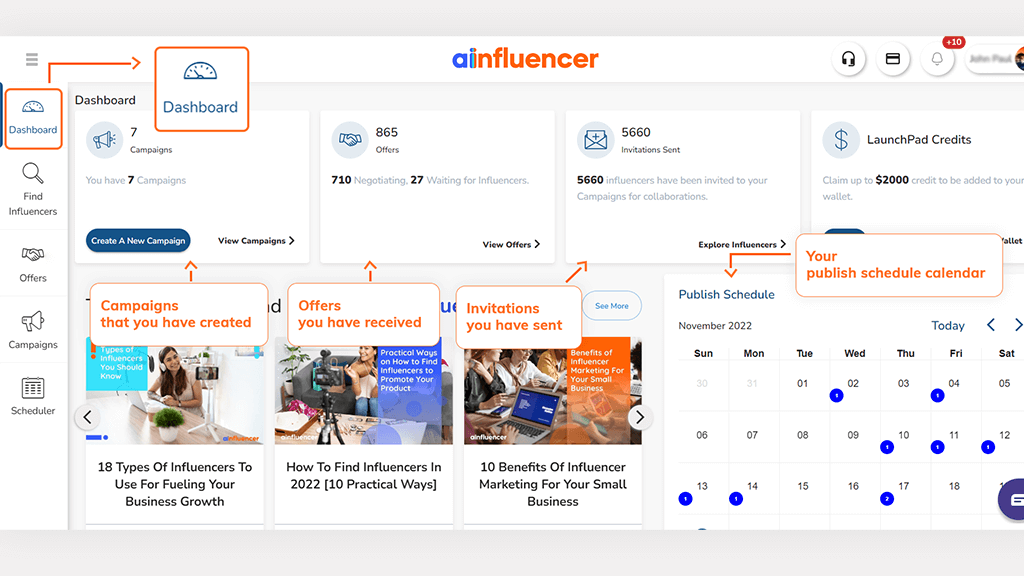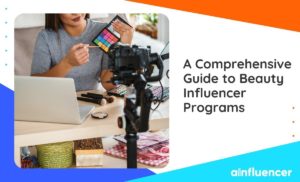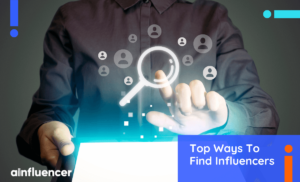Although influencers have been around forever, their star began to shine after the pandemic. Even marketing leaders agree that social media influencers are now crucial to the success and growth of brands.
Nano, micro, macro, and mega influencers are four types of influencers that should be known by everyone already. Brands should choose influencers that align with their marketing budget and share the same tone as their brand. There are more obstacles to even being able to find influencers that are a good fit for their brand—keeping abreast of developments in the field of influencer marketing rank high.
Keeping your influencer marketing campaigns in step with the latest developments can be daunting. But before we get too far into what are the best influencer marketing trends, let’s take a quick look at what “influencer marketing” means.
What Is Influencer Marketing?
Marketers use “influencer marketing” because it involves celebrities and other influencers helping to spread the word about a brand’s wares. Companies work with influencers to accomplish various goals, including increasing brand awareness, generating leads, enhancing the brand’s reputation, etc. Brands should remember to seek out influencers in their industry, thoroughly investigate the influencers’ profiles, and choose the best that meets all of the brands’ needs.
How To Find The Perfect Influencers?
The fast-paced development of influencer marketing is one of its many appealing features. Businesses today have many influencer finder tools and influencer marketplaces, making identifying and connecting with influencers a breeze.
Ainfluencer is an influencer marketplace that streamlines locating influential users on Instagram.
In contrast to its rivals, Ainfluencer does not require any upfront payment to gain access to its extensive database of influencers.
Additionally, you can negotiate with influencers using Ainfluencer’s in-app chat box, for a price that works for both of you.
Here’s an overview of Ainfluencer’s dashboard:

As you can see, it is simple and easy to use. In addition, Ainfluencer allows you to create campaigns and invite specific influencers or let the influencers find your campaign and make offers.
Let’s look at this video to learn about Ainfluencer and how to use it to discover Instagram influencers.
15 Top Essential Influencer Marketing Trends
55.4% of businesses used influencer marketing in 2019. Additionally, what was projected for 2022 showed an increase of 17.1%, and approximately 78.6% of U.S businesses have used influencer marketing in 2023, which is expected to increase in 2024. These numbers highlight the need to research and use influencer marketing trends and strategies, which will be very useful in 2024.
1. Use of influencers in affiliate marketing
The first influencer marketing trend to consider is the rise in the importance of influencers in affiliate marketing. It shouldn’t be forgotten to mention that people used to think of influencer and affiliate marketing as separate things. However, in actuality, they are intricately linked. In both cases, an “outsider” is trying to encourage followers to buy a specific product or service.
Traditional bloggers and publishers used to make up the bulk of affiliates. They’d include videos showing how the device works, giving users step-by-step instructions, and reviewing the product in detail. To boost their chances of earning referral fees from a wider audience, they also marketed various affiliate schemes, some of which were direct competitors.
However, things are beginning to shift. Now more than ever, celebrities and other public figures advise their followers to buy stuff and approve. They risk turning off their fan base by endorsing anything they do not believe. Therefore, companies are learning that influencers can be authentic brand advocates.
Influencers frequently provide first-person accounts, examples, and calls to action for a product or service. They may aid their audience down the sales funnel, from initial interest to final decision. And they do it all with genuine warmth and care. Many affiliates are beginning to partner with influencers to advertise their affiliate products since they need influencers’ enormous audiences.
2. More use of micro and nano influencers.
The second influencer marketing trend that brands should be aware of is the increasing attention of others to nano and micro influencers. Nano influencers, who have between 1K and 10K followers, are just one sort of influencers that marketers can work with. Micro influencers (those with 10K-100K followers), macro influencers (those with more than 100K followers), and mega-influencers (celebrities with millions of followers).
Although it shouldn’t be failed to say, finding nano influencers and working with them is less time-consuming and less expensive.
3. Higher payments for creators
Another influencer marketing trend that shows how the future of influencer marketing will be in the coming years is that content creators will receive higher payments. If you had told people ten years ago that becoming a “social media influencer” would be a respectable profession, they would have laughed in your face. However, in modern times, that is the case. There will be growing pressure for influencers to be compensated relatively as consumers, brands, and social media platforms realize the total worth of creators. You should expect to see more compensation schemes proposed by apps themselves (like TikTok’s Creator Fund) and more continuous commercial collaborations, all of which will provide influencers with additional opportunities to make a living wage.
Many creators are using OnlyFans and Patreon to paywall their work despite Facebook’s intention to pay $1 billion to creators in 2022. Twitch’s tipping system has resulted in millions of revenue for creators in a single year, and Twitter is launching a subscription model. Even social media platforms like Instagram and TikTok are trying out paid subscription models for creators.
4. The growth of Metaverse
One of the new marketing trends that shouldn’t be ignored is the growth of Metaverse. Even if you’re just beginning to understand it, the Metaverse is already here. The widespread adoption of the Metaverse is anticipated by the year 2024. There will be a sharp increase in investment in Metaverse technology, from $12 billion in 2020 to $72.8 billion in 2024.
It’s essentially a 3D internet, where our everyday lives are blended with computer-generated environments (AR and VR). Numerous interest-specific Metaverses, such as those devoted to gaming and the beauty industry, will entice influencers and brands from various demographics to enter this new digital world.
5. The Increase of LinkedIn “influencers”
While LinkedIn was first designed as a professional networking tool, its popularity skyrocketed in 2023 and 2024 as it morphed into a more conventional social media platform. The platform has even formed its own $25 million creator fund, and users are gaining followers, posting paid content, and making money off the forum as a whole.
What do we see for the future of influencer marketing on LinkedIn? More and more creators will use LinkedIn’s tools (such as creator mode) to grow their audiences, and more and more companies will recognize the value of these influencers.
6. More use of videos
Another growing trend in the influencer marketing industry is the use of video content in order to promote products. We are aware of the fact that for the past eight years, everyone in the marketing industry has agreed that video content is a must-have for their campaigns, whether they focus on using recent trends in marketing or not. There’s logic to that, too. Videos are popular among audiences. TikTok’s meteoric rise and Instagram’s recent rollout of highlight reels guarantee a flood of new video uploads.
Both content creators and marketers can benefit from monetizing and marketing to audiences who watch long-form videos. The point is that the likes of YouTube, Facebook, TikTok, Instagram Reels, and many other sites are hardly scratching consumers’ hunger for video.
The number of people watching live videos on Facebook rose by 50 percent between 2019 and 2020. Even if you account for the global pandemic and related lockdowns, a 50% rise is shocking.
7. An escalation in performance-based contracts
The new marketing trend toward long-term collaboration between businesses and influencers bodes well for the growth of performance-based influencer marketing. Clients will look to influencers to fulfill their stated goals, such as increased traffic or a specific volume of purchases.
Influencers offered a performance-based contract may seek to negotiate for continuing royalties instead of a lump sum. Before promising an inevitable return, you should also carefully research the contract you’re about to sign to ensure you understand your agreement.
8. The rise of Pinterest
Another influencer marketing trend is what Pinterest stores for its users. Recently, Pinterest has been working on a revamp of its home feed that prioritizes creator content, allowing users to view only pins that are most relevant to their interests. Takes, a new feature on the curation platform, will enable users to provide immediate feedback on creator material by pinning their ideas in response to it (its new multi-page video format).
It’s a lot like TikTok’s’stitch’ feature, only that instead of providing users with the opportunity to respond to a video, it actively pushes people to recreate the activity shown in the video to engage with one another and bond over a common interest.
Finally, Pinterest has launched its first in-product monetization program, ‘ Creators Rewards,’ which provides creators with advice, insights, and grants, showing that the platform is serious about competing with TikTok and building a new home for influencers.
9. The increase of short-form media on TikTok and long-form content on YouTube
TikTok is the future of influencer marketing and its leader at any given time. Since the commencement of the pandemic, TikTok has experienced a massive 180% spike among 15-25 year-old-users. There’s little doubt that TikTok’s popularity will keep increasing in 2024. Users average around 850 minutes per month using TikTok. To increase their output of short videos for promotion on social media, influencers increasingly turn to Tiktok.
Furthermore, if you plan on releasing extended video content, how do you do so? Currently, the most popular platform for video content creators is YouTube. An estimated one billion views were generated for the top 10 spenders on YouTube in 2021, as reported by YouTube’s Year In Review for that year. Influencer material — whether in-depth product evaluations or demo walkthroughs — can survive on this social media network for an extended period.
10. The need for sponsorship in social commerce
The tenth influencer marketing trend in this blog is the topic of sponsorships. In 2021, brands had to get more innovative to engage with consumers. Both traditional stores and online retailers rushed to accept the rise of online shopping, and online retailers, facing more competition, had to improve the convenience and ease with which they sold their products.
The year essentially compelled more companies to speed up their adoption of new technology, and the same was true for the developers of cutting-edge gadgets. As a result, social commerce has opened up fresh possibilities for influencer marketing and brand sponsorships.
With the advent of shoppable videos and posts, the transition from influencer content to brand channels and even further-reaching eCommerce solutions is now smooth for the consumer. Influencer marketers should look for brands willing to collaborate on campaigns incorporating shoppable content since these tendencies are likely to persist.
11. a rise in employee-generated content.
The desire to see a rise in employee-driven or employee-based content was a crucial influencer marketing trend in 2022. Since user-generated content has already been shown to affect sales and brand perception significantly, it only makes sense for companies to start treating their staff as influencers through employee advocacy initiatives.
In the past, we have observed the success of similar influencer marketing trends and strategies for well-known names like Macy’s. Macy’s encourages and financially compensates its employees who share content on social media demonstrating how they use Macy’s products in their daily life through its Style Crew program.
Customers are always interested in learning “how the sausage gets made,” so letting them into the store’s production facilities benefits both the customers and the workers. There’s a good reason why Wendy’s rebroadcasting the video of an employee cooking a Baconator gained over 3.4M views. Everyone is curious about the inner workings of a business. Permitting workers to disseminate this information makes perfect sense.
12. The need for building bonds with influencers.
Twelfth on the list of influencer marketing trends is the importance of creating bonds with influencers for companies in 2022, companies will start developing longer-term collaborations with brand ambassadors instead of just paying them for a single sponsored post. For the sake of credibility with consumers all across the world, it’s preferable to invest in genuine, long-term partnerships rather than random encounters.
Consider Gymshark as an illustration. Gymshark athletes are the company’s exclusive ambassadors and the reason for their fame. Of course, some creators may occasionally promote Gymshark by sharing paid material, but the company’s core influencer marketing strategy is built on lasting relationships with its athletes.
13. Promotion of Equality and Inclusion
The next influencer marketing trend to keep an eye on is the rising importance of equality and inclusion. Rising social action in 2020 brought attention to a sector’s vast shortage of diversity. Many content creators have spoken out about the need for more diversity in influencer marketing, with many firms being criticized for tokenism and unjust remuneration.
Sashagai Ruddock, a successful businesswoman and content developer said, “Representation matters because it inspires and can change how people see themselves and your brand.”
Though we agree that diversity and inclusion are not fads, we anticipate (and hope) that they will become the norm shortly. It will take more than just collaborating with influencers from different backgrounds. According to Larry Milstein, co-founder of PRZM: “It’s not enough to cast diversity and inclusion. It needs to be built into the fabric of the brand.”
14. Discussions on User-Generated Content
According to Forbes, more than 86% of businesses incorporate UGC in their marketing efforts. User-generated content (UGC) is trusted more than branded advertising, increases product legitimacy, and is fantastic for populating a feed with visually appealing posts.
For example, instead of spending money on traditional advertisements, Lush has opted to have customers post pictures they’ve taken of its products online. This makes sense, as reaching out to millennial and Gen Z customers via influencer marketing is an effective strategy.
The legality of reposting UGC is unclear. A continuation of discussions is expected. Some artists prefer to be credited in the first line of a caption rather than at the end. Many people are concerned about having their names appear above the fold.
15. Podcasts are the most exciting medium available.
The last on the list is the rising importance of podcasts. Companies will prioritize working with podcast influencers in the next year. Why? As a result of the pandemic, there has been a dramatic increase in the number of people actively listening to audio discussions.
The podcasting industry is predicted to expand from its 2020 valuation of $11.46 billion at a CAGR of 31.1%. Since more people were listening to audio during the lockdowns, more personalities and producers started focusing on that medium.
It stands to reason that by 2020, advertisers will have spent $800 million on podcasts. But that doesn’t mean you can still share photographs and content on social media. To this day, Instagram is still one of the most widely used social media channels for influencer marketing.
In contrast, 2022 saw a rise in the prominence of audio recordings.
8 Influencer Marketing News You Should Know About
Here are the eight best influencer marketing news worth looking at:
1. Kami, a Virtual Influencer With Down Syndrome
Down Syndrome International (DSI) is unveiling the first virtual influencer with Down syndrome. Virtual influence’s future raises many concerns. It doesn’t appear that the purpose is to elicit pity; instead, it suggests that the weird realm of virtual power might promote diversity in the public domain. F&B Singapore proposed the idea to help DSI increase Down syndrome inclusion.
Before today, her Instagram account, @itskamisworld, featured genuine ladies with Down syndrome. Daz3d was used to create Kami’s final 3-D shape. She’s not just one person; she represents many.
“I rarely see Down syndrome persons online.” Cameron James-Wilson, founder and CEO of The Digitals, says machine learning is crucial for creating an accurate 3-D figure. “Generating Kami’s initial design with an algorithm erased unconscious beauty prejudice,” explains James-Wilson.
“We wanted Kami’s DNA to represent all the features and qualities of these ladies with Down syndrome. ” Kami’s Instagram will behave like an influencer’s today. Rachel Kennedy and Firdaus Yusoff of Forsman & Bodenfors Singapore created Kami to reinterpret Down syndrome online.
How the world welcomes Kami in her virtual form will determine her true potential. “Down Syndrome International aims to enhance Down syndrome patients’ lives worldwide. “Creating characters like Kami challenges digital interface layers that lack inclusion,” James-Wilson says.
2. Launching of Super Follower-Only Spaces by Twitter
Twitter’s rolling out a new subscriber-only element to help creators build their in-app communities, with Super Follower-only Spaces now available to selected creators that offer subscriptions. “Now, with Super Follows-only Spaces, creators can provide an extra layer of conversation to their most prominent supporters beyond Tweets by engaging them through live audio.
Those who aren’t paying subscribers will still be able to see these broadcasts when shared, but they’ll need to sign on as a Super Follower to get access. Super Follows remains a minor element as Twitter continues experimenting with creator monetization features to give top creators more reasons to make the app a more significant focus.
Users that do have Super Follows available can set a monthly subscription cost of between $2. 99 and $9. 99 a month, with Twitter taking a small percentage of each transaction.
Part of the problem with Super Follows, however, is that there’s not a heap of reason for people to pay, as they’ve been able to access people’s tweets for free forever.
The process does enable creators to share exclusive tweets with their paying subscribers, and there are other ways to offer members-only elements. This is where Super Follower Spaces could come into play, and it could be a simple lure to help creators maximize their subscribers in the app. We’ll find out – Twitter says the option is being rolled out to all Super Follower creators from this week.
3. “Talking shop on Twitter” Conversation
People are harnessing the power of Twitter while they shop, looking for advice about what’s good, where to find it, and ultimately, flexing their new purchases on the timeline.
Take your chance to connect with shoppers as they seek the best intel and value from highly engaged communities on Twitter.
No matter where they are in their shopping journey, people are Tweeting nonstop about what they want to buy and seeking recommendations from communities that feel the same.
From fashion to family, you can help shoppers decide how to spend their money next by tapping into these distinct worlds on Twitter.
So, keep everything on the table and engage everyone who has the potential to connect and shop with your brand. Sure, the biggest retail rush is at the end of the year, but people have other significant shopping moments circled on the calendar.
These annual occasions also create conversations full of passionate shoppers, so ensure your brand engages with these key events on Twitter before excitement peaks.
It’s always time to shop, and the conversations happen all year long in diverse communities on Twitter. Does your brand have it in the bag when connecting with shoppers?
4. Prediction of TikTok surpassing YouTube in the US
The forecast: US TikTok users will spend more time with the social media platform this year than YouTube users will spend on YouTube.
TikTok’s reputation for luring people is rising fast. In 2020, users spent 38.6 minutes on TikTok, 4 minutes more than Facebook’s 34.6 minutes, despite peak use.
- TikTok is targeting YouTube as Facebook usage declines. ByteDance’s app released 3-minute and 5-minute videos last year.
- In February, the app introduced 10-minute videos.
- Joy Ventures and getWizer say 40% of Gen Z spend over 3 hours daily on TikTok.
- The same percentage of Gen Z spends more than 3 hours on YouTube, so social media addiction is common to TikTok.
- TikTok is imitated. TikTok mimics. Instagram and YouTube are using Reels and Shorts to compete with TikTok.
- TikTok competes with Twitter’s Repost function, Snapchat, Instagram, and Twitch’s desktop live streaming software.
5. The necessity of normalizing NFTs by creators on Instagram
Soon, buying an NFT on Instagram might be the same as purchasing a pair of shoes or a new dress on the platform. That’s what the Meta-owned platform is shooting for with updates that let creators create, buy and sell “digital collectibles,” hoping that it will help normalize and scale NFTs and open up a new revenue stream.
Instagram has given a trial group of creators with NFT experience access to a new end-to-end toolkit, which enables them to make, buy and sell NFTs, as well as connect a crypto wallet to display those they already own (the display feature was trialed in May and rolled out in August).
The new NFT capability could be a welcome boost for Instagram parent company Meta, which has announced plans to lay off 11,000 employees amid a contraction in e-commerce sales, economic downturn, and loss in advertising revenue (the company said at the beginning of the year that it stood to lose $10 billion in 2022 following Apple’s privacy changes).
Instagram will take a cut of NFT revenue in at least 2024 in a bid to get more of its 2 billion monthly active users on board. Many creators have no prior experience with blockchain, and there is growing skepticism of NFT hype and cryptocurrencies — especially in the wake of last week’s crypto crash.
6. Popularity of Pinterest
Pinterest had another up-and-down year, but it’s on the upswing again.
After seeing a massive surge in usage due to COVID lockdowns, Pinterest’s viewership reverted to the mean when physical stores reopened. Still, it’s reigniting its product discovery/eCommerce drive under new CEO and former Google commerce chief Bill Ready.
If done well, there are enormous opportunities for Pinterest’s future:
1. Globalization
Pinterest is doing well in its significant markets but needs to grow elsewhere.
As these data show, Pinterest’s North American revenue dwarfs other regions. While Pinterest is expanding, it must build its ad chances to maximize its potential. In 2023, Pinterest will focus more on overseas markets and localize its ad tools.
2. Search and discovery refinement
Discovery is Pinterest’s backbone, and with a former Google head at the lead, you can anticipate this to remain a significant priority as it seeks to spotlight the most relevant items through improved search tools and procedures.
Pinterest continues to offer more tailored discovery tools and refine and optimize its procedures to maximize product discovery based on user usage behaviors and preferences. Expect Pinterest to include more product comparison capabilities to help customers find deals.
7. Launching an e-commerce feature in the TikTok app
TikTok quietly entered the United States e-commerce market this week, where it will compete with Amazon and other retail giants during the coming holiday shopping season.
Users can now make purchases directly through the app using a TikTok Shop feature, which the company officially began testing in the U.S. this week. It was previously only available in the UK and seven countries in Southeast Asia.
We’ve seen the positive impact of TikTok Shop, and we’re excited to continue experimenting with this new commerce opportunity to support businesses of all sizes,” a TikTok spokesperson said. Semafor previously reported on TikTok’s American e-commerce ambitions, which are part of a more comprehensive company initiative referred to internally as “Project Aquaman. ”The goal is to import a version of China’s $400 billion Livestream shopping industry to the U. S.
Where the format is still essentially synonymous with television networks like QVC.
8. Not seeing Snapchat as a priority
Snapchat has never been a top priority for creators, and it doesn’t look like that will change anytime soon. This year alone, Snapchat appeared to increase its support for creators through new revenue programs, top features to enhance their Snapchat experience, and master classes.
And that’s off the back of the launch of two big projects this year: its first accelerator program, the $120K Black Creator Accelerator Program, which, as the name suggests, provides $10,000 per month of funding to 25 emergings, undiscovered Black talent, for 12 months.
So Snapchat has some love for creators. Even so, it just doesn’t seem enough to make creators feel wanted.
What can brands achieve with influencer marketing
In essence, influencers are just another name for an online celebrity who works as an unofficial brand ambassador. Below are companies’ most effective strategies to capitalize on influencers’ fan bases.
1. Increase in sales
Influencers have extraordinary sway with their audiences. In one survey, 38% of online buyers say they rely on influencer recommendations, and 30% say they are receptive to hearing from influencers multiple times each day, according to a recent survey. In this way, influencers can motivate their audiences to do things like visit an e-commerce site, explore a brand’s social media profiles, and ultimately make a purchase.
Also, it’s effective: Thanks to endorsement deals, HiSmile has topped $130 million in revenue. The dental care brand struck promotional arrangements with three major influencers: mixed martial arts star Conor McGregor and Jenner sisters Kylie and Kendall. When these celebrities and influencers praised the HiSmile brand, new customers flocked to the company’s retail location.
There was a 90% increase in overall male clients and a fivefold return on ad spending thanks to the Instagram campaign featuring Conor McGregor. The company has grown to have over three million social media followers, 5.5 billion social media impressions, and 1.5 billion views on its social videos across Instagram and YouTube.
2. Brand awareness and trust
Promoting goods and services employing influential people entail capitalizing on the credibility these people have established among their target demographics. Customers recruited by influencers, therefore, are warm leads who are typically ready to buy rather than cold prospects who require additional nurturing.
To mark Mental Health Awareness Week, actor and content creator Tammin Sursok shared an emotional post about her collaboration with Lulusimonstudio. As a result, her target demographic became aware of the brand while already having faith in its legitimacy.
When consumers are worried about the economy, it’s crucial to lending them faith in the future (like they did during the pandemic). During the epidemic, consumers put more trust in influencers than they did in brands, according to a recent survey.
A powerful kind of external social proof, an influencer’s endorsement feels more genuine and relatable than a brand’s.
3. Increase in earned media value
Earned media value (EMV) provides a monetary value for the worth of impressions generated by an influencer. It helps brands estimate the return on investment (ROI) of third-party marketing activities like influencer marketing campaigns. It’s measurable in terms of social media traffic metrics like pageviews, unique visitors, and engagement metrics like likes, shares, and comments.
Because of the larger audience reached by influencer marketing, EMV benefits greatly. After spending a total of $172 million on influencer marketing, the top 20 shops made an astounding $3 billion in EMV, according to a study of more than 5.5 million postings.
Social proof from influencer content is an excellent addition to product sites. They encourage visitors to spend more time on the site and enhance sales by giving them more reasons to purchase.
conclusion
Calls to action, live videos, surveys, blogging, and competitions are tools influencers use to engage with their audiences. These influencers make clever use of their audiences on social media sites, including Instagram, TikTok, YouTube, Twitter, Snapchat, and Pinterest.
On the other hand, we must recognize the reality that influencers are also customers. They genuinely love and use the products they promote. Modern consumers are well-informed and discerning and appreciate genuine feedback on the things they’re considering buying.
The brands will have to put in more effort to win over consumers. Companies will leverage influential figures with distinctive voices to shape their brands, and marketing efforts will feature more heartfelt storytelling. Think about these tendencies while you plan your marketing strategies using these influencer marketing trends, and you’ll get fantastic outcomes.
What will the following steps be for influencer marketing? From 2022 onward, influencer marketing will be increasingly prevalent. Some of the most prominent developments in the industry include the proliferation of “micro” and “nano” influencers, the interest of major companies in long-term collaboration, the development of new forms of social media, the rise of performance-based contracts, and much more.
When compared to branded posts, content created by influencers tends to perform better. Compared to 38% who trust brand-produced content, 61% trust influencer recommendations. Sixty percent of marketers have reported that influencer-generated content outperforms branded posts and generates higher engagement.
Since 2019, the size of the worldwide influencer marketing market has increased by more than two times than before. Market worth hit a new high of $16.4 billion in 2022.

![Read more about the article How To Leverage Influencer Marketing For Startups [2024 Update]](https://blog.ainfluencer.com/wp-content/uploads/2022/04/How-To-Leverage-Influencer-Marketing-For-Startups-300x182.png)







